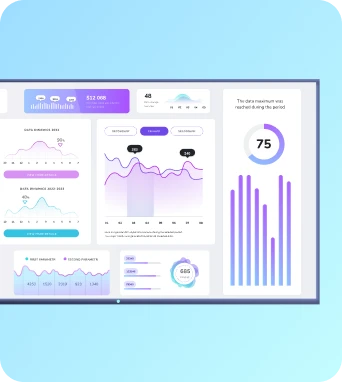Anti-glare coatings
Anti-glare coatings are thin surface treatments applied to display glass or acrylic that diffuse specular reflections and reduce visible glare. In digital signage they improve legibility, contrast and colour fidelity in bright or mixed lighting, helping TV dashboards and workplace displays remain readable from multiple viewing angles and under ambient light.
What is Anti-glare coatings?
Optical properties and technical considerations of anti-glare coatings
Anti-glare coatings operate by altering the interaction between incident ambient light and the display surface. Matte coatings use surface micro‑roughness to scatter specular reflections into a broad angular distribution, while multi‑layer anti‑reflective (AR) coatings use interference effects to cancel reflected wavelengths and reduce overall reflectance. The technical outcome for a digital signage installation is lower specular intensity and a larger range of viewing angles where content remains visible. For LED and LCD panels this affects both luminance and perceived contrast: a matte coating reduces peak specular highlights but can also slightly lower perceived sharpness and peak brightness compared to glossy glass. When integrating with signage players and content managed through Fugo.ai, it is important to account for that reduced peak brightness by using higher default luminance or contrast-aware templates to maintain readability of fine text and data visualisations on TV dashboards. Implementation on a hardware level often includes trade names and measurable metrics: haze percentage quantifies the degree of light scattering, while total reflectance indicates how much ambient light is returned to the viewer. For external-facing signage, coatings that combine anti-glare scattering with hydrophobic or oleophobic surface treatments improve durability and reduce cleaning frequency. In indoor workplace dashboards, coatings should be matched to ambient lighting conditions and sensor capabilities; for example, if a player or display includes an ambient light sensor that communicates with a cloud management platform like Fugo.ai, the software can dynamically ramp content contrast to compensate for the coating’s impact on perceived brightness. Examples encountered in large signage networks include replacing high-gloss glass with low-haze matte glass in reception areas where overlapping reflections from windows impede reading of KPI dashboards, and specifying AR coatings for meeting-room displays where colour-critical content must remain accurate.
Deploying anti-glare coatings in signage estates: practical steps and pitfalls
Deploying anti-glare coatings across a signage estate starts at procurement and continues through installation and monitoring. Specification should begin with an assessment of site lighting: measure peak lux levels, note the position of strong light sources and consider seasonal sun angles if installations face windows. Choose coating types aligned to the use case; matte micro-etch coatings suit high-reflection environments where legibility trumps absolute sharpness, while anti-reflective multi-layer coatings suit rooms where accurate colour reproduction and fine detail are essential. For touchscreen kiosks and interactive dashboards, ensure the coating preserves touch sensitivity and does not interfere with capacitive sensors. Procurement documentation should call out haze percentage and reflectance ratings, and request sample panels for on-site trials before mass ordering. During installation, orient displays and configure mounting to reduce direct reflections where possible, and calibrate display output through the content management system. Platforms like Fugo.ai can help by centralising player settings, pushing gamma and contrast profiles or scheduling display brightness changes tied to ambient light sensors. Common pitfalls include assuming one coating fits all locations, neglecting regular cleaning regimes that preserve coating performance, and failing to log ambient-light data for trend analysis. Monitoring should include periodic visual audits and automated telemetry from players that report brightness, power state and ambient lux if sensors are available. Optimisation is iterative: use A/B trials with different coatings or software presets, monitor content engagement and legibility metrics, and adjust both physical treatments and content design. Real-world examples include adjusting font weights and image processing on dashboards to compensate for the softer edge rendering that can result from heavier anti-glare finishes, or switching to higher-gain displays in transit hubs where coatings alone were insufficient against extreme ambient luminance.
Final Thoughts on Anti-glare coatings
Keep the learning going...
Android digital signage player
An Android digital signage player is an Android device or dedicated application that delivers scheduled multimedia playlists, HTML5 dashboards and data-driven layouts to TV and workplace displays. It connects to cloud platforms such as Fugo.ai for remote provisioning, content updates, reporting and integration with calendars, APIs and business intelligence feeds to automate screen content.
Animated widgets
Animated widgets are dynamic, self-contained content modules for digital signage that use vector animation, sprite sequences or timed transitions to convey information. They combine data bindings, animation timelines and lightweight assets to deliver attention-grabbing, loopable content on TV dashboards, workplace displays and networked signage players.
API integration (for signage)
API integration (for signage) is the programmatic connection between a digital signage platform and external systems, enabling automated content, data feeds, device control, and status reporting. It uses standard web APIs, webhooks, or SDKs to push JSON payloads, pull data, and synchronise playlists and player configurations across a signage estate.



